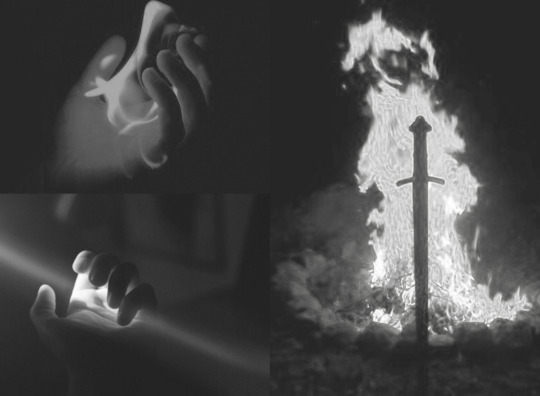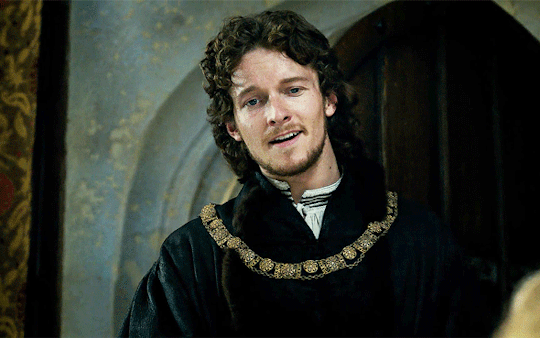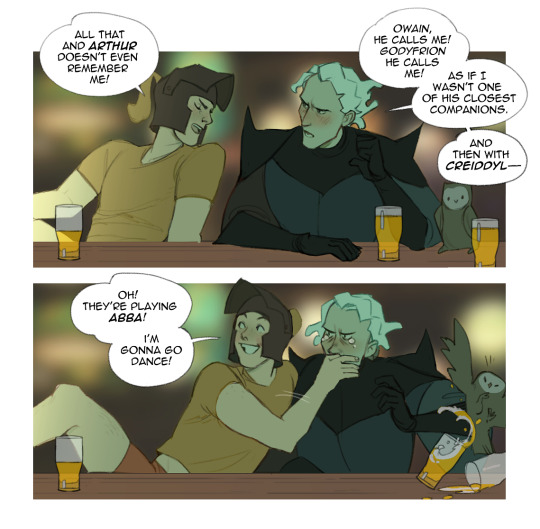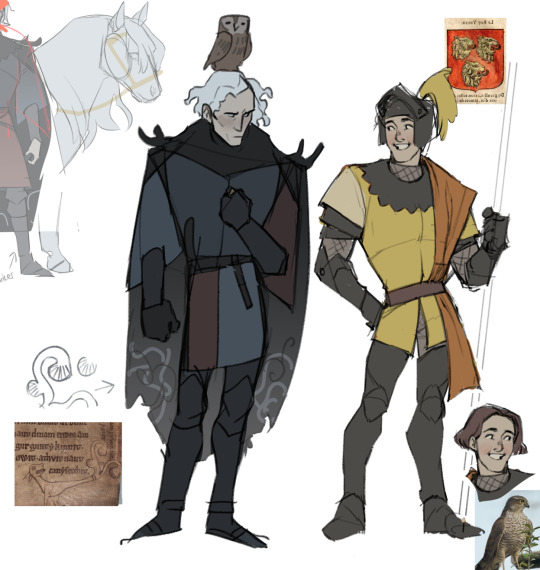#Arthur is welsh
Text

Tri Thiws ar Ddeg Ynys Prydain | Thirteen Treasures of the Island of Britain Series: 1/13 - Dyrnwyn, the Sword of Rhydderch Hael
The Dyrnwyn ("White-Hilt") is said to be a powerful sword belonging to Rhydderch Hael,[3] one of the Three Generous Men of Britain mentioned in the Welsh Triads. When drawn by a worthy or well-born man, the entire blade would blaze with fire. Rhydderch was never reluctant to hand the weapon to anyone, hence his nickname Hael meaning "the Generous", but the recipients, as soon as they had learned of its peculiar properties, always rejected the sword.
#we learn our history so we don't repeat it#this is the time to awaken Arthur#Arthur is welsh#merlin is Myrddin and lives in camarthen#independence is crawling ever near#welsh cultus#tylwyth teg#iolo morganwg was a liar#local folklore#the welsh gods#hud#cymraeg polytheism#welsh polytheism#welsh witchcraft#you shouldn't have removed your fathers head from the white hill Arthur!
32 notes
·
View notes
Quote
Historically, a sword identified as Excalibur (Caliburn) was supposedly discovered during the purported exhumation of Arthur's grave at Glastonbury Abbey in 1191.[26] On 6 March 1191, after the Treaty of Messina, either this or another claimed Excalibur was given as a gift of goodwill by the English king Richard I of England (Richard the Lionheart) to his ally Tancred, King of Sicily.[27] It was one of a series of Medieval English symbolic Arthurian acts, such as associating the crown won from the slain Welsh prince Llywelyn ap Gruffudd with the crown of King Arthur
Excalibur - Wikipedia
such as associating the crown won from the slain Welsh prince Llywelyn ap Gruffudd with the crown of King Arthur
#we learn our history so we don't repeat it#this is the time to awaken Arthur#Arthur is welsh#merlin is Myrddin and lives in camarthen#independence is crawling ever near#welsh cultus#tylwyth teg#iolo morganwg was a liar#local folklore#the welsh gods#hud#cymraeg polytheism#welsh polytheism#welsh witchcraft#you shouldn't have removed your fathers head from the white hill Arthur!
16 notes
·
View notes
Text
god i love bbc merlin fans ive never watched a single episode of ur show but ill make some like obscure ass post abt king arthur that... maybe??? vaguely??? accidentally also works for your arthur guy and yall descend on it like a swarm of locusts n suddenly im dealing w 5k notes. thanks besties
5K notes
·
View notes
Text




henry and elizabeth ( + baby arthur 🫶🏻)
#perioddramaedit#weloveperioddrama#the white princess#jodie comer#elizabeth of york#jacob collins levy#henry vii#arthur tudor#twpedit#jodiecomeredit#perioddramaonly#userladiesofcinema#userladiesblr#cinemapix#perioddramasonly#tvgifs#perioddramagif#gifshistorical#pdedit#nessa007#userfefa#otp: the welsh dragon and the english rose#costumegif#15th century#cinepix#dailytudors#tudorerasource#cinematv#*gifs#*gifset
277 notes
·
View notes
Text
𓃶 What Is The Wild Hunt?
The Wild Hunt is a common belief among many Northern European cultures. In short, the hunt is a cavalcade of ghosts, spirits, fairies, elves, and other spiritual beings that is said to sweep across our world every year. Depending on where your beliefs come from, when it happens will differ.
It is commonly believed that the leader of The Wild Hunt is a deity or figure of importance of some kind, such as Odin/Woden in Norse and Saxon traditions, or King Arthur in British lore. Other leaders of the hunt include but are not limited to:
𖤓 Arawn or Gwyn ap Nudd, commonly seen as the Welsh lords of Annwn
𖤓 Danish king Valdemar Atterdag
𖤓 The Norse dragon slayer Sigurd
𖤓 Biblical figures like Cain, Gabriel, Herod and the devil
𖤓 Gothic king Theodoric the Great
☾༺♰༻☽
𓃶 What Did People Do For The Wild Hunt?
The Wild Hunt was generally seen as a bad omen; one for destruction, famine, war, plague, or the death of the one who saw it. In many traditions, witnessing the hunt would result in the viewer being abducted to Otherworld or Underworld. Other times, those who were not protected would have their souls pulled from their bodies while they sleep, and they would join the menagerie of the dead.
To avoid this fate, people in Wales, for example, began the tradition of carving pumpkins as a way to avoid being taken by the fae. In Scandinavia, offerings like bread were put outside the home as an offering to the spirits joining Odin for the hunt.
☾༺♰༻☽
𓃶 When is The Wild Hunt?
Depending on where your beliefs stem from, there are various answers to this question.
In Britain, The Wild Hunt is associated with the autumn season, specifically around and on Samhain/The Autumn Equinox.
Scandinavian tradition tells us that they prepared for the hunt around December, specifically Yule/The Winter Equinox.
☾༺♰༻☽
𓃶 What Entities Are A Part of the Wild Hunt?
Many entities are associated with the Wild Hunt in different areas. These entities include but are not limited to:
𖤓 The Fae (The Sidhe, The Tlywyth Teg, etc)
𖤓 Spirits of the Dead
𖤓 Demons
𖤓 Valkyries
𖤓 The Spirits of Huntsmen or Nobles
𖤓 Horses (sometimes with an abnormal amount of legs)
𖤓 Wolves and dogs (sometimes spiritual in nature, i.e. the Cwn Annwn)
☾༺♰༻☽
#pagan witch#paganism#witchblr#witchcraft#the wild hunt#king arthur#avalon#gwyn ap nudd#arawn#welsh mythology#norse mythology#norse paganism#fairies#fae folk#fae#faerie#ghost#spirituality#celtic paganism
476 notes
·
View notes
Text
"And anyway, my family weren't even English!"
#sean's laugh fucking kills me#hua ha her 👹#ARTHUR ISN'T ENGLISH GOINF CRAZY WELSH ARTHUR REAL???#👈 is projecting#but seriously he's welsh to me#I drank pirate rum instead of a health cure and charles was sitting next to me#he was like “drinking again arthur?” and giggled#Im so normal about them#mick squeaks#arthur morgan#sean macguire#rdr2#red dead redemption 2#liveblogging
268 notes
·
View notes
Text

group therapy (they make each other worse)
#gwyn ap nudd#edern ap nudd#blodeuwedd#arthuriana#mabinogion#pa gur#medieval literature#welsh mythology#artists on tumblr#digital art#alcohol cw#art tag#------------------------------------------------------------#just as i don't think owain ap nudd exists i think gwyn godyfrion is gwyn ap gudd 😌#ok hear me out though#there are lots of gwyns in medieval welsh literature and i don't think they're all gwyn ap nudd (sadly)#but my man gwyn godyfrion. look. “dyfr” means water. like in the word dyfriog (watery). and gwyn ap nudd is very much associated with water#rides the watery horse du y moroedd. has a little chat with gwyddno garanhir who's the ruler of a kingdom that gets flooded.#dormach's funny flipper legs. rival gwythyr is associated with fire.#and there's the idea that annwn (of which gwyn ap nudd is the ruler) is itself underwater. and so on and so forth#sims-williams (‘the early welsh arthurian poems’ in arthur of the welsh. 1991) suggests godyfrion as a place name. underwater maybe.#so if gwyn godyfrion is “gwyn from under the water” i don't think it's unreasonable to suggest he's in some way connected to gwyn ap nudd#“but dizzy!! gwyn godyfrion is mentioned alongside gwyn ap nudd in culhwch and olwen!” the answer is that i simply choose to ignore that#while we're on the topic. the ddylad in creiddylad = flood#ok class dismissed#anyway gwyn and creiddylad i am pleased to tell you that my irl name means “sea” 😌 i am one of you
67 notes
·
View notes
Text




A Taste of Camelot
#camelot#illustrations#King Arthur#sir lancelot#guinevere#merlin#welsh mythology#morgan le fay#morgana#morgan pendragon#arthur pendragon
87 notes
·
View notes
Photo

the Passing of Arthur by dashinvaine
59 notes
·
View notes
Link
#welsh cultus#tylwyth teg#iolo morganwg was a liar#local folklore#the welsh gods#hud#cymraeg polytheism#welsh polytheism#welsh witchcraft#you shouldn't have removed your fathers head from the white hill Arthur!#we learn our history so we don't repeat it#this is the time to awaken Arthur#Arthur is welsh#merlin is Myrddin and lives in camarthen#independence is crawling ever near
5 notes
·
View notes
Text
Arthur, the Wizard-king
Since King Arthur is a bard (albeit a frivolous one) in Welsh Myth, that technically means Arthur is a magician in some capacity.
Bards/Poets in Celtic Culture and Myth are combo of newscaster, historian, genealogist, prophet and entertainer. They are essentially lore keepers - Walking libraries for a mostly illiterate society. Which is why they are placed in an esteemed social status. They not only entertain but can prophesize the future, rouse one's companions to action and curse people with satires, on top of preserving knowledge through poetic forms.
Taliesin and Myrddin Wyllt are examples of from welsh lore. In Irish myth, there's Laidcenn, Niall (of the nine hostages)'s poet, and I remember some poet-warrior threatened to lampoon Cu Chulainn.
I think evidence that points to Arthur's magic is in the story Gwyn, Gwythyr and Creiddylad:
If you interpret Gwyn and Gwythyr as mortal men, Arthur magically oath-bound two men to fight each other until judgement day, granting them immortality in the process.
If you interpret Gwyn and Gwythyr are divine beings, then Arthur cursed two gods to fight each other annually and organized the seasons.
No matter how you cut it, Arthur is pretty magically strong. Other magical facts about Arthur include:
Welsh Triads saying Arthur had the ability to render the land infertile for seven years wherever he walks.
Arthur having an invisibility cloak, like Harry Potter. It was called "Gwenn", apparently.
Oral Folklore that says that Arthur can shapeshift into a raven or chough. Which is why it's bad luck to kill one.
Uther, Arthur's dad, being the creator of one of the "Three great enchantments of Britain", which was then taught to Menw ap Teirgwaedd, an enchanter knight of Arthur's. In his death-song, Uther even boasts about being a "great enchanter". (unless I'm mistaken)
#uther pendragon#king arthur#gwyn ap nudd#gwythyr ap greidawl#creiddylad#arthuriana#arthurian legend#arthurian legends#arthurian mythology#welsh triads#welsh mythology#celtic mythology#menw ap teirgwaedd#bardism
62 notes
·
View notes
Text
Flew into to Vancouver today for a speaking engagement, and the guy sitting next to me on my connecting flight was watching Passengers. Looked over for one moment and there was Michael as the robot bartender. I can't escape...

#michael sheen#welsh seduction machine#passengers#arthur#michael sheen stop following me challenge#at least he wasn't in my falafel#lolz#traveling#public speaker#personal post#good times
63 notes
·
View notes
Text
Inktober day 26: 'remove'

#inktober#inktober remove#king arthur#arthur pendragon#arthurian legend#celtic mythology#welsh mythology#art#artists on tumblr
55 notes
·
View notes
Text
Living in Wales where the names Arthur and Morgan originated from (and are very common) is so funny because now I can only think of one guy with those names from now on 😞 so here's some fun facts!
"Arthur" originates from "arto"/"arth" which means bear in Welsh (also said to have originated from the Celtic goddess of bears, Artio), and "Morgan" is a combination of two words - "môr" meaning sea and "cant" meaning circle/hundred, the full name "Morgan" means sea-dweller!
So traditionally, Arthur Morgan's name would be Arthos Môrcant!
#strong believer of welsh-american arthur morgan#don't mind me fellers#does dim ffordd dyw e ddim yn gymraeg#yn onest...#gobeithio y bydd hyn yn ddiddorol i chi!!!#sean pokes fun at arthur calling him english even when arthur said he isn't english#probably just a jab at england being so close to wales and all#arthur morgan#rdr2#red dead redemption 2#red dead redemption community#mick squeaks#<3
117 notes
·
View notes
Text
Deep dives into folklore: Welsh folklore

Welsh folklore is a rich tapestry of myths, legends, and traditional stories that have been passed down through generations, shaping the cultural identity of the Welsh people. Rooted in a landscape steeped in history and mysticism, Welsh folklore reflects the unique character of Wales and its people. Let's take a deep dive into some key aspects of Welsh folklore:
The Mabinogion:
The Mabinogion is a collection of Welsh prose tales, comprising some of the earliest literary works in the Welsh language. It consists of four branches: Pwyll Pendefig Dyfed, Branwen ferch Llŷr, Manawydan fab Llŷr, and Math fab Mathonwy.
These tales are a blend of mythology, legend, and fantasy, featuring gods, heroes, and magical elements. Notable characters include Pryderi, Rhiannon, and Bran the Blessed.
The Red Dragon:
The Red Dragon is a symbol deeply ingrained in Welsh folklore and mythology. Legend has it that the red dragon was the emblem of Cadwaladr, a legendary king of Gwynedd. The dragon is associated with Welsh identity and pride and is prominently featured on the national flag of Wales.
King Arthur and the Welsh Connection:
The legendary King Arthur has strong ties to Welsh folklore. While the broader Arthurian legend is widespread, some key elements, such as the magical sword Excalibur and the wizard Merlin, have roots in Welsh tales like the Mabinogion.
Places like Caerleon and the ruins of Castell Dinas Bran in Llangollen are often linked to Arthurian legends.
Y Tylwyth Teg (The Fair Folk):
The Tylwyth Teg are Welsh fairies or magical beings often associated with mounds or fairy rings. They are known for their beauty and magical abilities. Crossing paths with them could lead to both blessings and misfortune, depending on the encounter.
Tales warn of the Tylwyth Teg taking humans to their underground realm, where time passes differently.
The Legend of Gelert:
The legend of Gelert is a poignant tale of loyalty and tragedy. It tells the story of Llywelyn the Great, a medieval Welsh prince, and his faithful hound Gelert. The dog is mistakenly killed by Llywelyn, who later discovers that Gelert had actually saved his son from a wolf.
The Mari Lwyd:
The Mari Lwyd is a traditional Welsh custom associated with the winter season. It involves a horse's skull mounted on a pole, decorated with ribbons and bells, carried by individuals who go from house to house, engaging in a form of door-to-door singing and challenge.
Celtic Water Spirits:
Wales, with its rivers, lakes, and coastline, has numerous tales of water spirits. Creatures like the Afanc, a lake monster, and the Gwragedd Annwn, beautiful water maidens, are part of Welsh folklore. These spirits often play pivotal roles in cautionary tales and myths.
Branwen Uerch Lyr:
The tragic tale of Branwen, the sister of the legendary King Bran the Blessed, is another prominent story in Welsh folklore. It involves betrayal, war, and the symbolic connection between Wales and Ireland.
Welsh folklore continues to inspire contemporary literature, art, and cultural expressions, maintaining a strong connection to the country's past. The tales and mythical elements contribute to the unique identity of Wales and its people, adding a layer of enchantment to the historical and natural landscape.
Taglist (reply or reblog to be added):
@axl-ul @crow-flower @thoughts-fromthevoid @alderwoodbooks @harleyacoincidence @tuberosumtater @sonic-spade @theonlygardenia @holymzogynybatman @nulliel-tres @w0rkah0licz @sylvanthorn @tigertaurus22 @profiterole-reads @mathias-musings @1899adgg1997tbmd @grimmparanormalinvestigations
#deep dives into folklore#writeblr#writers of tumblr#writing#bookish#booklr#fantasy books#creative writing#ya fantasy books#book blog#ya books#folklore#welsh folklore#mythology#welsh mythology#merlin#king arthur#emrys#bedd gelert
35 notes
·
View notes
Photo

gwyn and edern (and blodeuwedd)
i wanted to design a gwyn ap nudd that isn't just herne the hunter 2.0. i like gwyn's association with the mist and dark, lonely places. i think blodeuwedd would be his friend
i also like to imagine edern is an annoying little brother lol
#welsh mythology#Y Mabinogi#the mabinogion#gwyn ap nudd#edern ap nudd#arthuriana#medieval literature#character design#mythology#folklore#blodeuwedd#celtic mythology#geraint and enid#this is the most self indulgent thing i've ever created lmao#i gotta make edern's outfit more flashy#and sparrowhawky#they're both knights of king arthur#and they're both poor little meow meows in their own way 😘#art tag
351 notes
·
View notes